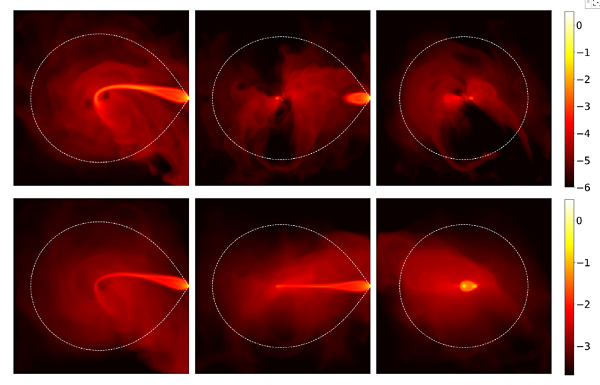Dr. JIAO Cheng-Liang from Yunnan Observatories of the Chinese Academy of Sciences, collaborating with Prof. XUE Li, the leader of this research, and his group in the Department of Astronomy of Xiamen University, performed three-dimensional (3D) simulations of the accretion flow in the progenitor of Tycho’s supernova, which helps identifying the physical properties of the accretion process. The research was recently published online in Monthly Notices of the Royal Astronomical Society.
Type Ia supernovae (SNe Ia) plays an important role in astrophysics, especially in cosmology, as “standard candles”, and in galactic chemical evolution, with their contribution of iron to host galaxies. SNe Ia can be triggered by a carbon–oxygen white dwarf (CO WD) accreting sufficient material from a non-degenerate companion star, i.e. the single-degenerate (SD) model. Tycho's supernova (SN) is a famous SN for which a series of studies favors the SD model. Recent observations of its remnant suggests that the SN ejecta should have evolved in a bubble blown by a latitude-dependent wind, yet how this wind is formed is still not very clear.
The researchers performed 3D simulations of the accretion flow in the progenitor of Tycho’s SN, and studied the wind structure in different situations. They found that when the magnetic field in the accreted material is negligible, outflowing wind is concentrated near the equatorial plane. When the magnetic field has energy equipartition with internal energy, polar wind is comparable with the equatorial wind. A carefully chosen magnetic field between the above two cases (B = 5.44×103G, in the order of magnetic field in sunspots) can roughly reproduce the latitude-dependent wind required to form the peculiar periphery of Tycho’s SN remnant. This magnetic field may contain the tangled magnetic field in the accreted material obtained from the surface of the companion star, as well as contributions from the WD.
The research reveals the importance of magnetic field in the progenitor of Tycho’s SN. It also provides a new source of mass-loss, other than the mass-loss caused by hydrogen and helium flashes on the WD surface, which are often considered in binary evolution researches. The mass-loss ratio is extremely large (above 90 per cent) in the simulation, yet it is consistent with researches in accretion physics, and this outflow only lasts for a limited time before the SN explosion (~10-7Msun/yr for ~105yr), so it does not handicap the mass accumulation of the WD much.

Figure 1. Images of density at the final time of the simulation run for B = 5.44×103G. The three upper subplots are the central slices extracted from the cardinal planes with z = 0, y = 0, and x = 0 from left to right, respectively. The three lower subplots are the corresponding integral images along the same line of sight. The white dashed line is the projection of the Roche lobe on the plane perpendicular to the line of sight. The density and column density in the subplots are calibrated with logarithms of scaled values (Image by JIAO Cheng-liang)
Contact:
JIAO Cheng-Liang
Yunnan Observatories, CAS
jiaocl@ynao.ac.cn